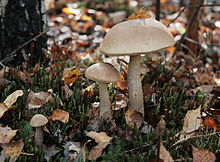Leccinum holopus
| Leccinum holopus | |
|---|---|

| |
| Scientific classification | |
| Domain: | Eukaryota |
| Kingdom: | Fungi |
| Division: | Basidiomycota |
| Class: | Agaricomycetes |
| Order: | Boletales |
| Family: | Boletaceae |
| Genus: | Leccinum |
| Species: | L. holopus
|
| Binomial name | |
| Leccinum holopus (
Rostk.) Watling (1960) | |
| Synonyms[1] | |
| |
| Leccinum holopus | |
|---|---|
| Pores on hymenium | |
| Cap is convex or depressed | |
mycorrhizal | |
| Edibility is edible | |
Leccinum holopus, commonly known as the white birch bolete, white bog bolete, or ghost bolete, is a species of
Taxonomy
Initially named as a species of
The specific epithet holopus is Greek for "with perfect stalk".[11] Common names given to the fungus include white birch bolete, white bog bolete,[12] and ghost bolete.[13]
Several subtaxa of Leccinum holopus have been described. In
Description

Leccinum holopus produces a brown
Several
Similar species
Leccinellum albellum is similar in appearance to L. holopus, but grows in association with oak and has a more southerly distribution.[25] L. scabrum is a widely distributed lookalike that can be distinguished from L. holopus by its larger size and generally darker colors.[26]
Edibility
Although commonly considered
Habitat and distribution

Leccinum holopus is a
Fruitbodies of L. holopus are a source of food for
See also
References
- ^ a b "Leccinum holopus (Rostk.) Watling". MycoBank. International Mycological Association. Retrieved 2015-01-17.
- ^ Rostkovius FWT. Deutschlands Flora, Abt. III. Die Pilze Deutschlands (in German). Vol. 5-23/24. Nürnberg: Sturm. pp. 85–132 (see p. 131, t. 48.
- .
- ^ Pilát A. (1951). Klíc urcování nasich hub hribovitých a bedlovitých (in Czech). Prague: Brázda. p. 65.
- ^ Šutara J. (1982). "Nomenclatural problems concerning the generic name Krombholziella R. Maire". Česká Mykologie. 36 (2): 77–84.
- ^ Konrad P, Maublanc A (1952). Les Agaricales 2: Russulacées, Hygrophoracées, Gomphidriacées, Paxillacées, Bolétacées. Encyclopédie Mycologique (in French). Vol. 20. Paris: Paul Lechevalier. p. 116.
- ^ "GSD Species Synonymy: Leccinum holopus (Rostk.) Watling". Species Fungorum. CAB International. Retrieved 2015-01-17.
- ^ Lannoy G, Estadès A (1994). "Contribution à l'étude du genre Leccinum S. F. Gray – 4 – Essai de clé monographique du genre Leccinum S. F. Gray". Documents Mycologiques (in French). 24: 1–29.
- ^ Lannoy G, Estadès A (1991). "Contribution à l'étude du genre Leccinum S. F. Gray – 1 – Étude de L. variicolor, oxydabile et de quelques satellites, formes et variétés". Documents Mycologiques (in French). 21 (81): 11–26.
- PMID 17604144.
- ISBN 978-0-919433-47-2.
- ^ ISBN 978-0-8156-0588-1.
- ISBN 978-1-4472-6402-6.
- ISBN 978-80-200-1717-8.
- ^ Smith AH, Thiers HD (1971). The Boletes of Michigan. Ann Arbor, Michigan: University of Michigan Press. pp. 182–4.
- ^ Lannoy G, Estadès A (1993). "Contribution à l'étude du genre Leccinum S. F. Gray – 3 – Étude de Leccinum nucatum sp. nov., Leccinum brunneogriseolum fo. chlorinum fo. nov. et L. molle avec comb. nov. de L. coloripes Blum". Documents Mycologiques (in French). 23 (89): 63–71.
- ^ Klofac W. (2007). "Schlüssel zur Bestimmung von Frischfunden der europäischen Arten der Boletales mit röhrigem Hymenophor". Österreichische Zeitschrift für Pilzkunde (in German). 16: 187–279 (see p. 257).
- ^ a b den Bakker HC, Noordeloos ME. (2009). "The genus Leccinum in Western and Central Europe". Retrieved 2015-01-18.
- ^ "Record Details: Leccinum holopus var. nucatum (Lannoy & Estadès) Klofac". Index Fungorum. CAB International. Retrieved 2015-01-18.
- ^ Singer R. (1966). Die Pilze Mitteleuropas, Band VI: Teil 2, Die Boletoideaea und Strobilomycetaceae (in German). Bad Heilbrun: Klinkhardt. p. 98.
- ^ "Record Details: Leccinum holopus var. majus (Singer) Singer". Index Fungorum. CAB International. Retrieved 2015-01-18.
- ISBN 978-0-7112-2378-3.
- ISBN 978-0-7627-3109-1.
- ^ ISBN 978-0-252-07976-4.
- ISBN 978-1-933202-36-5.
- ISBN 978-0-395-91090-0.
- ^ ISBN 978-0-472-03126-9.
- ^ ISBN 978-0-226-72117-0.
- ^ Kuo M. (April 2007). "Leccinum holopus". MushroomExpert.Com. Retrieved 2015-01-24.
- PMID 33873790.

- .
- ^ Fu SZ, Wang QB, Yao YJ (2006). "An annotated checklist of Leccinum in China". Mycotaxon. 96: 47–50.
- ISBN 978-0-231-05694-6.
